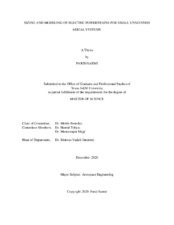| dc.description.abstract | The following describes development of performance models for the battery, motor controller (electronic speed controller, or ESC), and brushless DC (BLDC) motor of small unmanned aerial systems (UAS) with a gross takeoff weight less than 20 kg (55 lb). The thesis also develops a sizing algorithm for the brushless DC motor.
The performance models for the motor, ESC, and battery use component specifications to enable pre-conceptual design space exploration and mission-based design optimization of small UAS powertrains without a library of test data. The models also enable tradeoffs analysis between existing and conceptual designs without a series of flight tests. To develop, tune, and validate the models, a custom dynamometer test setup was designed and built to measure torque, speed, and electrical power data of brushless DC motor drive systems. The validated models, which could predict the combined motor/ESC efficiency within 5\% points of experimental values, reveal that popular claims of "high efficiency" for electric powertrains are only valid in a narrow band of high speed/low torque operation.
Conversely, the sizing algorithm can predict the mass, geometry, and figure of merit (k_m) of a motor rated for a given torque. The algorithm can then predict the optimal torque constant (k_t), speed constant (k_v), and winding resistance (R) given an operating voltage and shaft speed. To develop and validate the algorithm, complementary theoretical and experimental methods were used to overcome two key barriers: (1) motor performance theory was used to generate non-existent performance data, and (2) empirical trends in motor design were leveraged to connect independent theoretical torque, volume, and mass models. The resulting mass and figure of merit predictions are within \pm20\% of actual values for motors ranging in mass from 25--500 g (1--18 oz.) and varying geometries. The validated algorithm also revealed that motor size (and therefore mass) grows with torque, not power. | en |


